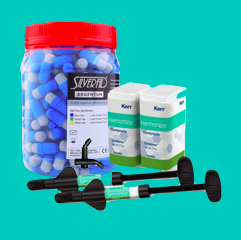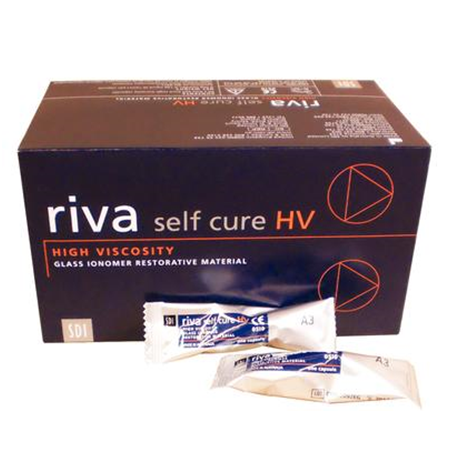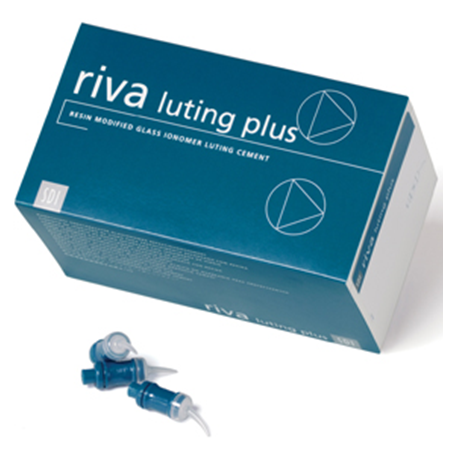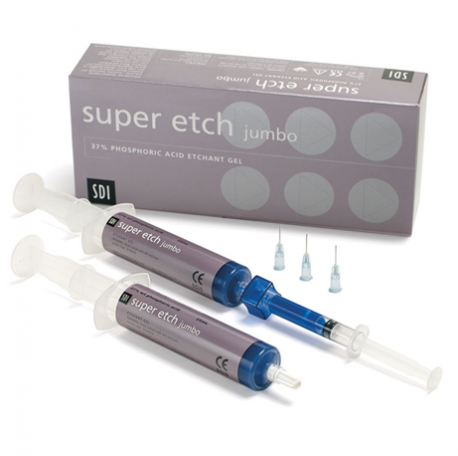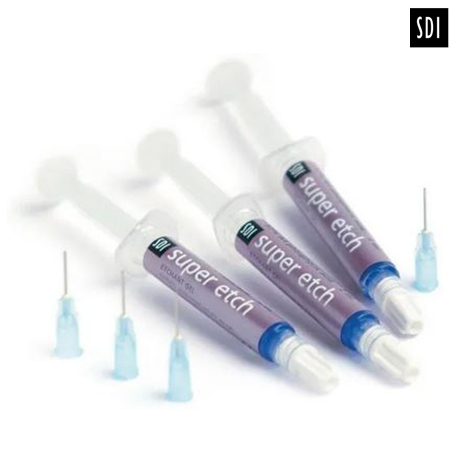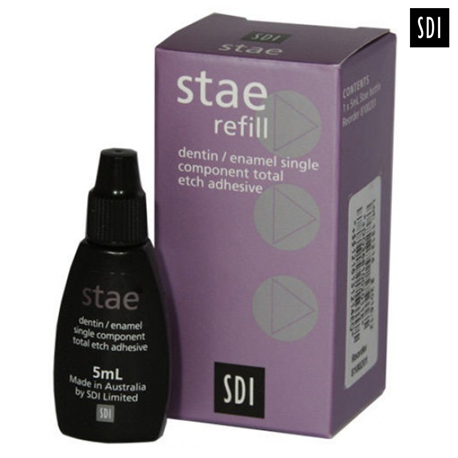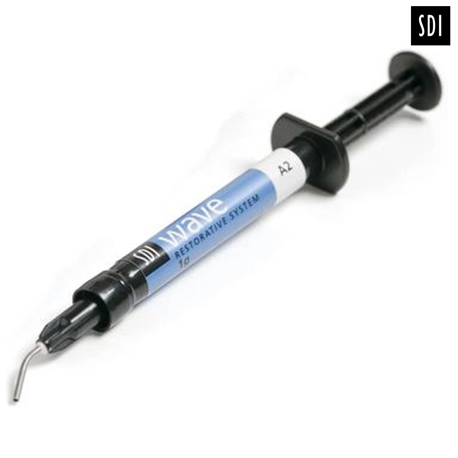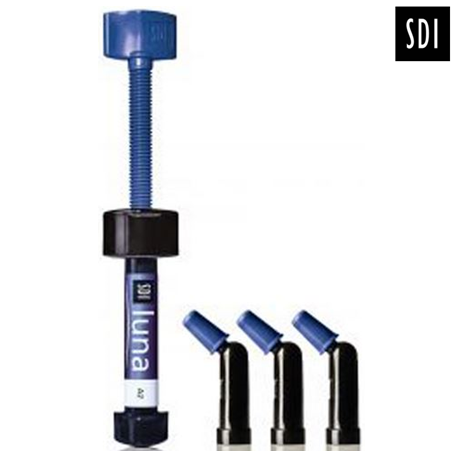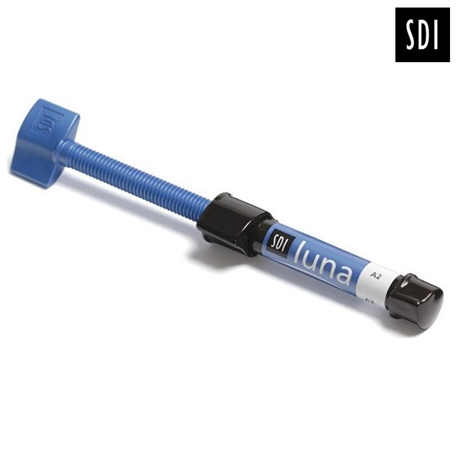STORAGE AND HANDLING Do not remove Riva Self Cure HV capsules from their foil packets until ready to use. Store at temperatures between 4° and 20°C (39° - 68°F). For optimum freshness, refrigeration is optional. Use at room temperature between 20° and 25°C (68° - 77°F). Bioactive proprietary ionglassTM technology Riva Self Cure utilizes SDI’s proprietary ionglass™ filler developed by our glass technologists. ionglass™ is a radiopaque, high ion releasing, bioactive glass used in SDI’s range of glass ionomer products. Riva Self Cure releases substantially higher fluoride to assist with remineralization of the natural dentition. The strongest dentin replacement When dentin is missing, use Riva Self Cure to replace it. It is the best dental material available today that virtually mimics dentin. No adhesive is required, and sensitivity is non-existent. Like dentin, Riva Self Cure has a very high compressive strength, ensuring it will withstand long term mastication forces. Surface hardness The greater the surface hardness, the greater the resistance to abrasive wear. Riva Self Cure is a dynamic glass ionomer cement that can withstand high penetration of the surface. Low acid erosion Riva Self Cure has a very low acid erosion value. This improves the longevity of the restoration, resisting disintegration and wear caused by oral acidity. The ISO Standard dictates that a material cannot have acid erosion of more than 0.17mm.
STORAGE AND HANDLING Do not remove Riva Self Cure HV capsules from their foil packets until ready to use. Store at temperatures between 4° and 20°C (39° - 68°F). For optimum freshness, refrigeration is optional. Use at room temperature between 20° and 25°C (68° - 77°F). Bioactive proprietary ionglassTM technology Riva Self Cure utilizes SDI’s proprietary ionglass™ filler developed by our glass technologists. ionglass™ is a radiopaque, high ion releasing, bioactive glass used in SDI’s range of glass ionomer products. Riva Self Cure releases substantially higher fluoride to assist with remineralization of the natural dentition. The strongest dentin replacement When dentin is missing, use Riva Self Cure to replace it. It is the best dental material available today that virtually mimics dentin. No adhesive is required, and sensitivity is non-existent. Like dentin, Riva Self Cure has a very high compressive strength, ensuring it will withstand long term mastication forces. Surface hardness The greater the surface hardness, the greater the resistance to abrasive wear. Riva Self Cure is a dynamic glass ionomer cement that can withstand high penetration of the surface. Low acid erosion Riva Self Cure has a very low acid erosion value. This improves the longevity of the restoration, resisting disintegration and wear caused by oral acidity. The ISO Standard dictates that a material cannot have acid erosion of more than 0.17mm.
Indications Cementation of resin, metal, or porcelain fused to metal inlays, onlays, bridges and crowns Cementation of ceramic inlays and crowns Cementation of pins, posts and screws High fluoride release Riva Luting Plus’s free movement of fluoride provides benefits to the tooth. Fluoride plays several significant roles in any caries – prevention program. These include the formation of fluorapatite, which is more acid resistant than hydroxyapatite. Fluorapatite is very important for tooth remineralization. Clinically insoluble Riva Luting Plus is clinically insoluble when set. It has a very low acid erosion value. This improves the longevity of the restoration, resisting disintegration and wear caused by oral acidity. The ISO Standard dictates that a material cannot have acid erosion of more than 0.17mm. Setting times There will be minimal loss of working time when using Riva Luting Plus. With adequate working time and a quick setting property, Riva Luting Plus will shorten chair time and ensures early resistance to mastication forces. Flexural strength Ensuring reduced cracking and failure in flexion, Riva Luting Plus’ high flexural strength ensures longevity of the restoration. Very low film thickness Riva Luting Plus quickly flows into the preparation. A low film thickness allows the seating of tight fitting indirect restorations.
37% promotes strong bonding Super Etch 37% wt phosphoric acid etchant for enamel and dentin. Easily controlled Super Etch gel flows under direction, not under gravity.
Features 37% wt phosphoric acid 30 to 40% wt phosphoric acid optimally etches in 15 to 20 seconds (1). Lower concentrations require longer contact time, unnecessarily delaying procedures. Selective enamel etching Super Etch’s high viscosity and easy to control fl ow allows precise placement. It is perfect for selective enamel etching procedures Blue tint gel High visibility for precise selective placement. Thixotropic gel Super Etch non-slump gel offers precise selective placement. Agitate the gel to lower its viscosity. Super Etch Super Etch creates micropores in the enamel surface and removes the smear layer to unblock dentinal tubules. It promotes adhesive resin penetration and resin tag formation. Super Etch is vital for the restoration’s mechanical retention. Dye free Etchant A clear dye free 37% liquid etchant is also available for patients who suffer dye allergies. Super Etch syringes Super Etch offers an easy to use, leak free syringe. Direct extrusion facilitates faster procedures, economical dispensing and easier access into diffi cult to reach areas. Super Etch Low Viscosity (LV) LV is specialized for sealants with a half gel / half liquid formulation. Super Etch LV’s high fl owability achieves greater acid surface contact for deeper etchant penetration into pits and fi ssures. The deeper acid penetration strengthens the mechanical bond and the retention success of the sealant. Ideal for SDI’s Conseal f and all other sealants. Super Etch syringe tips Super Etch tips - 23 gauge straight tips Direction to Use INSTRUCTIONS: Isolate tooth. Prepare cavity. Clean the surface to be etched using a non-fluoridated, oil-free prophylaxis paste, or a pumice and water slurry. Rinse thoroughly with water. 1. Acid etching. Thoroughly dry the surface to be etched with dry, oilfree air. CAUTION: ensure that the dispensing tip hub is firmly attached to the syringe by twisting the tip hub securely onto the syringe. The Super Etch tip may be bent to any desired angle. Place the tip against the surface to be coated and slowly apply the gel. Note: on first usage, or after prolonged storage, extrude a small amount onto a mixing pad for familiarity with the etchant’s viscosity and rate of extrusion. Etch enamel for at least 30 seconds. Etch exposed dentin and glass ionomer liner for 20 seconds. 2. Rinse well with water for 5-10 seconds. 3. Remove excess water 4. Apply bonding agent, such as Stae, or pit and fissure sealant, such as Conseal f, according to manufacturer’s instructions.
Features :- One bottle system Stae combines both primer and adhesive in one bottle to simplify the technique and decrease patient chair time. Fluoride release Fluoride’s cariostatic effect enhances remineralization and inhibits enamel demineralization. In an aqueous environment, the fl uoride ions in Stae diffuse from the resin into the surrounding tooth. This ionic movement is caused by oral fl uid passing in and out of the resin and tooth, acting as a carrier for the fl uoride ions. Non Bis-phenol A Stae avoids the Bis-phenol A hormonal imbalance controversy, as it does not contain the related BisGMA resin. Bonds to moist and dry tooth surfaces Stae’s carrier solvent is a mixture of acetone and water. The acetone carries Stae deep into the demineralized dentin and the water re-moistens any dry dentin. High bond strength Stae’s complete hybridization of the resin into the demineralized dentin results in high bond strength. Key Specifications :- COMPOSITION: Acrylic monomer Acetone Fluoride Stabilizer Packaging :- 1 x 5ml Stae bottle Direction to Use :- 1. Clean and isolate tooth. Rubber dam is the preferred mode of isolation 2. Prepare a conservative cavity, employing standard techniques 3. Use a calcium hydroxide liner and appropriate glass ionomer cement liner to protect deep cavity preparations in close proximity to the pulp 4. Thoroughly dry the bonding surfaces of the tooth with dry, oil-free air 5. Etch with Super Etch 37% phosphoric acid (SDI Limited) for at least 20 seconds. NOTE: Enamel subjected to fluoridation should be etched for 90 to 120 seconds. IMPORTANT: If using an etch syringe, ensure that the dispensing tip hub is firmly attached to the syringe by twisting the hub securely onto the syringe. On first usage or after prolonged storage, extrude a small amount onto a mixing pad for familiarity with the etchant’s viscosity and rate of extrusion. 6. Wash thoroughly with water. 7. Remove excess water. Keep moist. Avoid contamination e.g. saliva. 8. Apply Stae to saturate all internal surfaces 9. Blow gently with dry, oil-free air to evaporate solvent. Leave surface glossy 10. Light cure for 10 seconds. NOTE: do not polymerize Stae by itself in a mixing well; it will be a non – polymerized looking material. Stae contains a unique hydrophobic and hydrophilic monomer that does not cure when exposed to oxygen. The product will polymerize once covered by any lightcure composite restorative material 11. Place composite in increments of 2mm or less.
Features Nanofilled Wave, Wave MV and Wave HV contain specially treated nano-fi llers to maximize polishability, wear resistance and strength. Ease of extrusion is improved with the addition of these specially treated nano-fi llers. Filler loading Wave, Wave MV and Wave HV all have excellent wear profi les due to their high fi ller loading level: Fluoride release Fluoride’s cariostatic effect enhances remineralization and inhibits enamel demineralization. In an aqueous environment, the fl uoride ions in Wave, Wave MV and Wave HV diffuse from the resin into the surrounding tooth. This ionic movement is caused by oral fl uid passing in and out of the resin and tooth, acting as a carrier for the fl uoride ions. Natural fluorescence Wave, Wave MV and Wave HV contain a fl uorescent agent that ensures perfectly natural looking teeth under ultraviolet lights. No one will know! Radiopacity Wave, Wave MV and Wave HV are all visible on x-rays. This allows easy identifi cation of secondary caries at the interface. Compressive strength Wave’s, Wave MV’s and Wave HV’s high compressive strength values expand the suitability for multiple applications. UDMA Wave’s UDMA resin system minimizes shrinkage and reduces post operative sensitivity. Tip length comparison Wave’s complet tip length is 12.2mm, 40% longer than the alternative of 8.7mm. Wave’s longer tip length allows more direct placement of the material into diffi cult to reach areas. Direction to Use Clean and Isolate tooth. A conservative cavity should be prepared, employing standard techniques and instruments, to form a slightly rounded internal form. Margins of the cavity preparation should end in sound and supported enamel with no bevels in stress bearing locations. If bevelling is desired in a low stress location it should extend no further than 1mm at an angle of no greater than 45°. Pre-wedging is also recommended to ensure that the restored tooth will have an adequate contact point. Prophy all surfaces to be etched including surfaces adjacent to the cavity with an oil free non-fluoride containing paste or a slurry of pumice and water. Rinse thoroughly with water. Shade Selection Shade selection should be made with a just cleaned and moist tooth. NOTE: Do not use uncured paste for color matching as there is a slight color change upon curing. Isolation Isolation techniques must be used to prevent contamination. Rubber dam is the preferred mode of isolation. Pulp Protection For deep cavities, use a calcium hydroxide liner and appropriate glass ionomer cement liner to protect deep cavity reparations in close proximity to the pulp. 1. Acid Etching Thoroughly dry the surface to be etched with dry, oil-free air. Etch tooth surface with Super Etch 37% phosphoric acid. (a) Enamel only Etch surface for at least 20 seconds (b) Dentin and enamel Using the “total etch” technique etch the surface including any glass ionomer for at least 20 seconds. Enamel subjected to fluoridation should be etched for 90 to 120 seconds. Etching Precautions: Ensure that the dispensing tip hub is firmly attached to the syringe by twisting the hub securely onto the syringe. Avoid acid contact with oral tissues, eyes and skin. If accidental contact occurs wash thoroughly with water. In the case of eye contact, wash eye for 15 minutes and seek medical attention. Use matrix strips to protect adjacent tooth surfaces during etching. On first usage or after prolonged storage, extrude a small amount onto a mixing pad for familiarity with the etchant’s viscosity and rate of extrusion 2. Wash thoroughly with water 3. Remove excess water. Keep moist. Avoid contamination e.g. saliva 4. Apply Stae dentin/enamel adhesive to saturate all internal surfaces, or bonding agent according to manufacturer’s instructions 5. Blow gently with dry, oil-free air for 2 seconds to evaporate solvent. Leave surface glossy 6. Light cure for 20 seconds (460-480nm wavelength, high power LED curing light) 7. Directly inject Wave in increments of 2mm or less in: 7.1 Class V restorations, 7.2 Tunnel preparations, 7.3 Pit and fissures sealants, 7.4 Minimal Class I, Class II, Class III and Class IV restorations. Or other indication as required. CAUTION: ensure that the dispensing tip is firmly attached to the syringe by twisting the tip hub securely onto the syringe.




